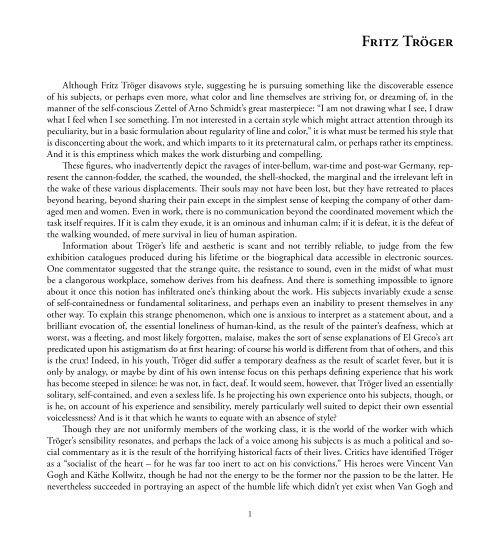Fritz Tröger - Pierre Menard Gallery
Fritz Tröger - Pierre Menard Gallery
Fritz Tröger - Pierre Menard Gallery
Create successful ePaper yourself
Turn your PDF publications into a flip-book with our unique Google optimized e-Paper software.
Although <strong>Fritz</strong> <strong>Tröger</strong> disavows style, suggesting he is pursuing something like the discoverable essence<br />
of his subjects, or perhaps even more, what color and line themselves are striving for, or dreaming of, in the<br />
manner of the self-conscious Zettel of Arno Schmidt’s great masterpiece: “I am not drawing what I see, I draw<br />
what I feel when I see something. I’m not interested in a certain style which might attract attention through its<br />
peculiarity, but in a basic formulation about regularity of line and color,” it is what must be termed his style that<br />
is disconcerting about the work, and which imparts to it its preternatural calm, or perhaps rather its emptiness.<br />
And it is this emptiness which makes the work disturbing and compelling.<br />
These figures, who inadvertently depict the ravages of inter-bellum, war-time and post-war Germany, represent<br />
the cannon-fodder, the scathed, the wounded, the shell-shocked, the marginal and the irrelevant left in<br />
the wake of these various displacements. Their souls may not have been lost, but they have retreated to places<br />
beyond hearing, beyond sharing their pain except in the simplest sense of keeping the company of other damaged<br />
men and women. Even in work, there is no communication beyond the coordinated movement which the<br />
task itself requires. If it is calm they exude, it is an ominous and inhuman calm; if it is defeat, it is the defeat of<br />
the walking wounded, of mere survival in lieu of human aspiration.<br />
Information about <strong>Tröger</strong>’s life and aesthetic is scant and not terribly reliable, to judge from the few<br />
exhibition catalogues produced during his lifetime or the biographical data accessible in electronic sources.<br />
One commentator suggested that the strange quite, the resistance to sound, even in the midst of what must<br />
be a clangorous workplace, somehow derives from his deafness. And there is something impossible to ignore<br />
about it once this notion has infiltrated one’s thinking about the work. His subjects invariably exude a sense<br />
of self-containedness or fundamental solitariness, and perhaps even an inability to present themselves in any<br />
other way. To explain this strange phenomenon, which one is anxious to interpret as a statement about, and a<br />
brilliant evocation of, the essential loneliness of human-kind, as the result of the painter’s deafness, which at<br />
worst, was a fleeting, and most likely forgotten, malaise, makes the sort of sense explanations of El Greco’s art<br />
predicated upon his astigmatism do at first hearing: of course his world is different from that of others, and this<br />
is the crux! Indeed, in his youth, <strong>Tröger</strong> did suffer a temporary deafness as the result of scarlet fever, but it is<br />
only by analogy, or maybe by dint of his own intense focus on this perhaps defining experience that his work<br />
has become steeped in silence: he was not, in fact, deaf. It would seem, however, that <strong>Tröger</strong> lived an essentially<br />
solitary, self-contained, and even a sexless life. Is he projecting his own experience onto his subjects, though, or<br />
is he, on account of his experience and sensibility, merely particularly well suited to depict their own essential<br />
voicelessness? And is it that which he wants to equate with an absence of style?<br />
Though they are not uniformly members of the working class, it is the world of the worker with which<br />
<strong>Tröger</strong>’s sensibility resonates, and perhaps the lack of a voice among his subjects is as much a political and social<br />
commentary as it is the result of the horrifying historical facts of their lives. Critics have identified <strong>Tröger</strong><br />
as a “socialist of the heart – for he was far too inert to act on his convictions.” His heroes were Vincent Van<br />
Gogh and Käthe Kollwitz, though he had not the energy to be the former nor the passion to be the latter. He<br />
nevertheless succeeded in portraying an aspect of the humble life which didn’t yet exist when Van Gogh and<br />
1<br />
<strong>Fritz</strong> <strong>Tröger</strong>


